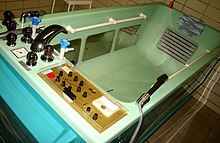Underwater pressure jet massage
The underwater pressure jet massage (UWM or UWAM; sometimes confused with the underwater massage) is a therapy that belongs to both massages and hydrotherapy . The patient sits in a bathtub and is massaged with water, which comes from a water hose at high pressure.
history
Not much is known about the history of underwater pressure jet massage. The idea of performing a massage with the help of a water hose seems to have arisen at the beginning of the 20th century. Initially, the tubs were made of enamelled cast iron . In recent years, however, as with the Stangerbad , glass-fiber reinforced plastic has become established for the manufacture of bathtubs.
application
The special tub for the UWM consists of three components. The first component is the tub itself. The second component is the pump unit, which provides three processes for the UWM. In the circulation process , the water hose is supplied with the water from the tub. The temperature of the "new" water corresponds to the bathing water temperature. The second, so-called, additional water process supplies the water hose with new water. So the massage can be applied with warmer water. To do this, the tub must have a temperature sensor that compensates for the water temperature against the warmer water from the hose. In both of these processes, the unit delivers a pressure of 0.5 to 3 bar. The third method is known as the suction method and is the opposite of the circulation method. In this type of UWM, water is drawn into the hose and a negative pressure is created as soon as the patient's skin seals the nozzle. This treatment is very similar to cupping . The last component to be mentioned is the hose. This has a device at the free end to change the nozzle. This means that nozzles with different cross-sections can be used.
Application value
In previous years, only the water pressure produced by the unit was used to describe the strength of the UWM. However, this statement is imprecise because the interchangeable nozzles change the cross-section and thus the amount of water ejected. The application value was introduced to compensate for this inaccuracy . This is calculated from the water pressure ( bar ) * water volume ( l / min ) and gives a more precise statement about the effect on the patient. However, a trap is hidden here too. An application value of 46 can be achieved with 1 bar water pressure and a nozzle cross section of 80 mm² or a water pressure of 1.5 bar and a nozzle cross section of 40 mm². For this reason, the application value is only used as a guide value and not as a fixed value.
effect
Three areas can be defined for the impact of the UWM. In the first area, which relates to the muscles and tissues, relaxation and decongestion take place. The metabolism and nutrition ( trophics ) of the tissue are stimulated and thus absorption in the tissue is promoted. Scarring and sticking of the tissue are loosened. The second area includes the effects on the heart and blood circulation. Here there is a reduction in high blood pressure and an increase in the pulse rate and stroke volume . The peripheral vascular resistance is reduced and the breathing rate increased. The last area includes the effect on the nervous system . There is pain relief and an overall vegetative switch in the direction of vagotonia .
indication
As already mentioned, the UWM can be applied in a strong and weakened form. How strong the application value should be depends entirely on the disease to be treated. Especially with contractures , e.g. A strong form of UWM is indicated , for example due to scars, myogelosis and hypotonic muscles . A psoriasis vulgaris should be treated with a high application value. Most indicated clinical pictures should, however, be treated with a wide nozzle and / or little pressure. These include atrophy , muscle tension , strains of the ligaments and muscles , arthrosis and ankylosing spondylitis . In addition to these diseases of the musculoskeletal system , there are also a number of indications under the organ, circulatory and neurological diseases. These include chronic constipation , non-acute diseases of the gallbladder , peripherally - arterial circulatory disorders , the leg ulcers , Parkinson's disease and sensory disturbances . Particularly when treating diseases of the internal organs, care must be taken to ensure a low application value with a wide nozzle cross-section.
Contraindication
Due to the warm water and the hydrostatic pressure that acts on the patient, patients with cardiovascular diseases must not be treated. These include B. the heart attack , inflammation of the pericardium, the arterial hypertension and the Roemheld syndrome . Treatment with the UWM must also be avoided in the case of cirrhosis of the liver , circulatory disorders of organs and a tendency to bleed. It is particularly important to ensure that patients with malignant tumors and metastases (even if only suspected) and with varices in the area to be treated must not under any circumstances undergo UWM.
Differentiation from underwater massage
The term underwater massage , which is often misused to refer to underwater pressure jet massage , is a simpler form of this treatment. The patient also sits in a bathtub with warm water, but is massaged directly with the therapist's hands. The warmth and buoyancy of the water can increase the effect of a conventional massage.
literature
- Otto Gillert, Walther Rulffs: Hydrotherapy and Balneotherapy. Theory and practice . Pflaum 1990. ISBN 3-7905-0586-2
- Bernard Kolster, Gisela Ebelt-Paprotny: Guide to Physiotherapy. Findings, techniques, treatment, rehabilitation . Urban & Fischer Verlag 1996. ISBN 3-437-45160-X
- Willibald Pschyrembel : Pschyrembel naturopathy and alternative healing methods . Gruyter 1996. ISBN 3-11-018524-5

